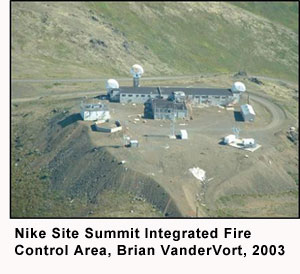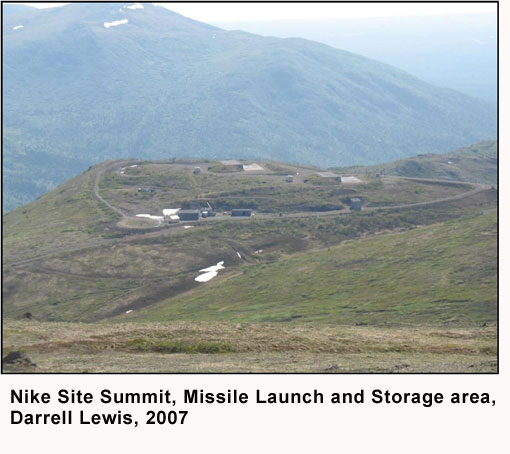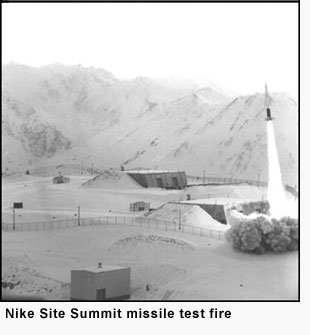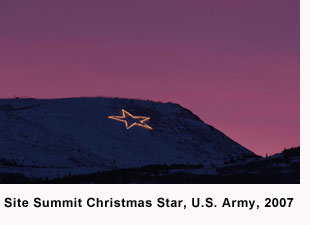The History of Nike Site Summit
Nike Site Summit is a former U.S. Army Nike Hercules missile installation that sits atop Mount Gordon Lyon in the Chugach mountains on the eastern edge of Joint Base Elmendorf-Richardson adjacent to Chugach State Park. Sitting at 3,900 feet above sea level, the Integrated Fire Control Area or Battery Control Area overlooks Anchorage, Eagle River, and JBER. It was one of 145 Nike Hercules sites, and part of an extensive defense network that protected the U.S. during the Cold War. Of these 145 sites, 110 were upgraded Nike Ajax missile sites, while 35, including those in Alaska, were completely new sites. Eight Nike sites were constructed in Alaska; five around Fairbanks and three around Anchorage. Nike Site Summit is the most intact site of its kind in the nation and was listed in the National Register of Historic Places in 1996 as a nationally significant site.

Site Summit was constructed by the Patti-MacDonald Company, M-B Contracting Company, and Connelly Construction Company, beginning in May 1957 and completed in September 1958, with the work being completed over two construction seasons (May-September). Construction involved blasting 60 vertical feet off of Mount Gordon Lyon to provide a level space for the IFC area and leveling a ridge for the missile launch and storage area. A road of approximately 1.5 miles was cut to connect the two areas.
Site Summit was kept operational from 1959 to 1979 by the soldiers of the 4th Missile Battalion, 43rd Artillery (re-designated the 1st Battalion, 43rd Air Defense Artillery in 1972). Typically, 125 soldiers were needed to operate a Nike site. Housing at the Battery Control building could accommodate fifty men. Although not all personnel were required to live on the premises, the site was staffed 24 hours a day, seven days a week.
The Integrated Fire Control Area
Along with the other Alaskan Nike sites, Site Summit was uniquely designed to accommodate Alaska's harsh climate. In the IFC, the battery control operations and housing were integrated into a single composite building due to weather conditions. The building contained the communications and radar equipment, command center, common areas such as the kitchen, dining hall, PX, and recreation rooms, and living quarters. The radar control vans were located inside the mechanical area of the battery control building. The radars were covered with protective, retractable steel clamshell covers.

The Missile Launch and Storage Area
At the missile launch and storage area, de-icing mechanisms such as heating coils were used to keep the launch pads ice-free so the missiles could be launched on a moment's notice, even in inclement weather. The missile storage buildings were constructed above ground - instead of below ground, as was typical for a Nike site. The Missile Launch and Storage area consisted of the missile launch and storage buildings, the warhead magazine, and the launch control building. The dog kennels were also located in this area. The area was protected by two fences; the outer, limited-area fence was the first line of protection guarding the missiles and was patrolled by sentries and guard dogs. The inner fence surrounded the exclusion zone where the launch area was located.
FIRE!

Controlling the missiles was a system of radars at the IFC area, that identified enemy targets, and computers located in the radar control vans. The acquisition radar swept the sky searching for enemy aircraft. The target ranging radar prevented the enemy's attempts to jam the tracking radar. Once an enemy target was identified, the target tracking radar locked onto the target and fed information about the enemy's movement to the system's computer. Information about the target was relayed from the missile tracking radar to the missile, ready at the launch area below. At the appropriate time, the battery control officer commanded the launch control officer in the launch control building to push the "fire" button. The computers processed the information, calculated the impact point, launched the missile to intercept the target, and kept the missile on target. When the missile neared the target, the warhead exploded on command from the computers.
Today, Site Summit remains a physical representation of military strategy during the Cold War. Active for twenty years, Site Summit is a reminder of the United States Army's mission to protect its military bases and population centers.

The Christmas Star Story
A unique and lasting feature of Site Summit is the Christmas star that illuminates the side of Mount Gordon Lyon during the long winter nights. It was a gift to Anchorage from the soldiers of Site Summit. The star was the idea of the first battery commander, U.S. Army Capt. Douglas Evert. In 1958, a 15-foot star was constructed on the Site Summit gatehouse as a holiday symbol and reminder of the site's presence. However, the star was too small to be seen from Anchorage, so a 117-foot star was built on the mountainside in 1960. Since then, the star has been occasionally re-built after being wiped out by avalanches. In 1989, it was reconstructed to its current size of 300 feet wide. Work crews perform maintenance year-round on the star's 350 bulbs. The star is lit every year as part of Anchorage's "City of Lights" celebration on Thanksgiving weekend. It remains lit until the last Iditarod musher crosses the finish line in Nome, sometime in March. Since the attacks of 9/11 in 2001, the star also is illuminated every year on September 11th.